Complete Solution: Managerial Accounting and Finance Assignment
VerifiedAdded on 2023/06/07
|9
|1634
|185
Homework Assignment
AI Summary
This document presents a comprehensive solution to a Managerial Accounting and Finance assignment, covering key areas such as cost accounting, budgeting, and investment appraisal. The solution includes answers to multiple-choice questions related to fundamental concepts like cost behavior and financial statement analysis. Additionally, it addresses practical problems involving activity-based costing (ABC), comparing it with traditional absorption costing methods. Furthermore, the assignment delves into investment decision-making, calculating payback periods and net present values (NPV) for different projects, ultimately recommending the most financially beneficial option based on these analyses. The document also discusses the advantages and disadvantages of using NPV and internal rate of return (IRR) methods for project evaluation, providing a well-rounded overview of essential managerial accounting and finance principles. Desklib provides a platform for students to access similar solved assignments and past papers for effective learning.

Managerial Accounting
and Finance
and Finance
Paraphrase This Document
Need a fresh take? Get an instant paraphrase of this document with our AI Paraphraser
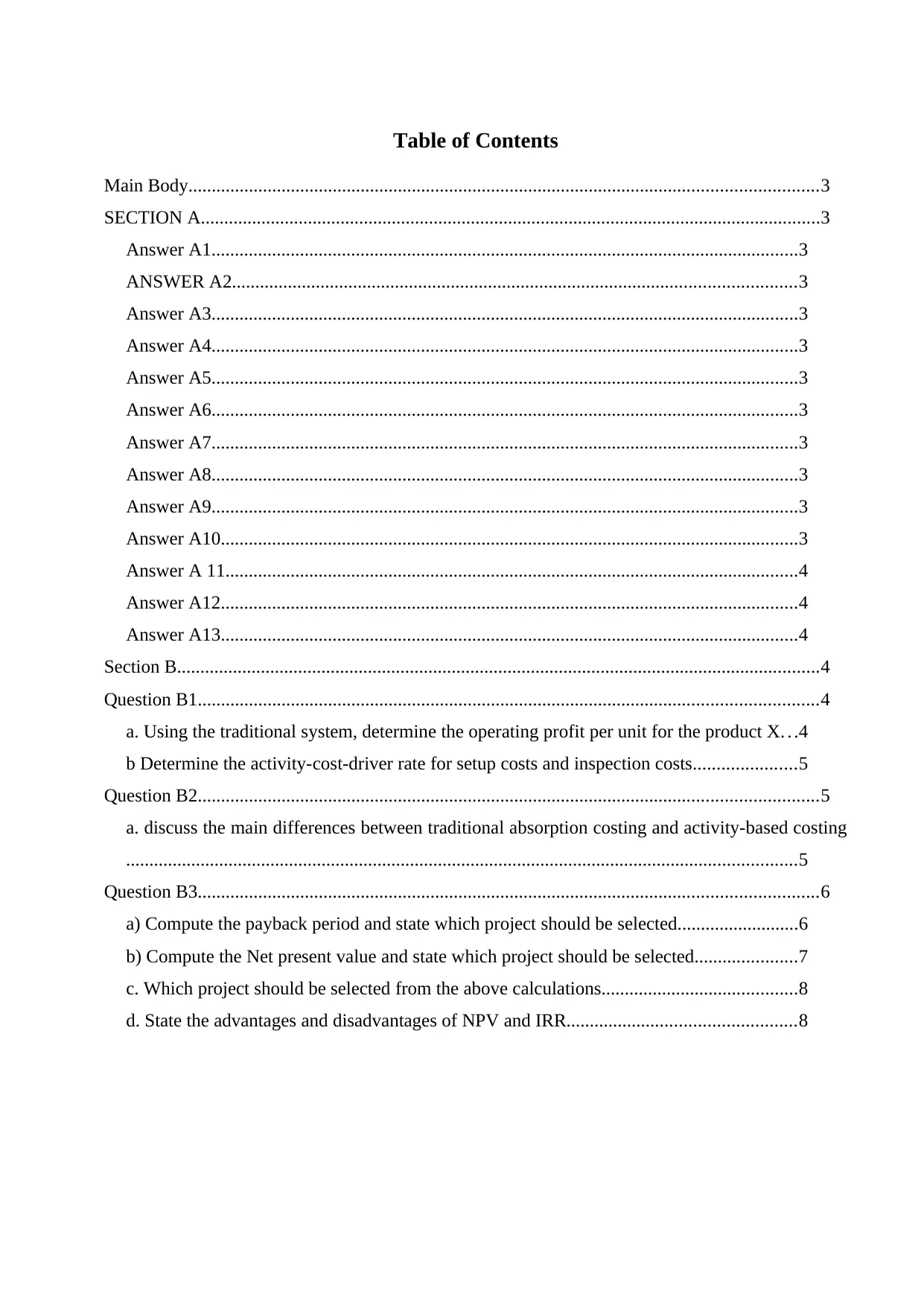
Table of Contents
Main Body.......................................................................................................................................3
SECTION A.....................................................................................................................................3
Answer A1..............................................................................................................................3
ANSWER A2.........................................................................................................................3
Answer A3..............................................................................................................................3
Answer A4..............................................................................................................................3
Answer A5..............................................................................................................................3
Answer A6..............................................................................................................................3
Answer A7..............................................................................................................................3
Answer A8..............................................................................................................................3
Answer A9..............................................................................................................................3
Answer A10............................................................................................................................3
Answer A 11...........................................................................................................................4
Answer A12............................................................................................................................4
Answer A13............................................................................................................................4
Section B..........................................................................................................................................4
Question B1.....................................................................................................................................4
a. Using the traditional system, determine the operating profit per unit for the product X. . .4
b Determine the activity-cost-driver rate for setup costs and inspection costs......................5
Question B2.....................................................................................................................................5
a. discuss the main differences between traditional absorption costing and activity-based costing
................................................................................................................................................5
Question B3.....................................................................................................................................6
a) Compute the payback period and state which project should be selected..........................6
b) Compute the Net present value and state which project should be selected......................7
c. Which project should be selected from the above calculations..........................................8
d. State the advantages and disadvantages of NPV and IRR.................................................8
Main Body.......................................................................................................................................3
SECTION A.....................................................................................................................................3
Answer A1..............................................................................................................................3
ANSWER A2.........................................................................................................................3
Answer A3..............................................................................................................................3
Answer A4..............................................................................................................................3
Answer A5..............................................................................................................................3
Answer A6..............................................................................................................................3
Answer A7..............................................................................................................................3
Answer A8..............................................................................................................................3
Answer A9..............................................................................................................................3
Answer A10............................................................................................................................3
Answer A 11...........................................................................................................................4
Answer A12............................................................................................................................4
Answer A13............................................................................................................................4
Section B..........................................................................................................................................4
Question B1.....................................................................................................................................4
a. Using the traditional system, determine the operating profit per unit for the product X. . .4
b Determine the activity-cost-driver rate for setup costs and inspection costs......................5
Question B2.....................................................................................................................................5
a. discuss the main differences between traditional absorption costing and activity-based costing
................................................................................................................................................5
Question B3.....................................................................................................................................6
a) Compute the payback period and state which project should be selected..........................6
b) Compute the Net present value and state which project should be selected......................7
c. Which project should be selected from the above calculations..........................................8
d. State the advantages and disadvantages of NPV and IRR.................................................8
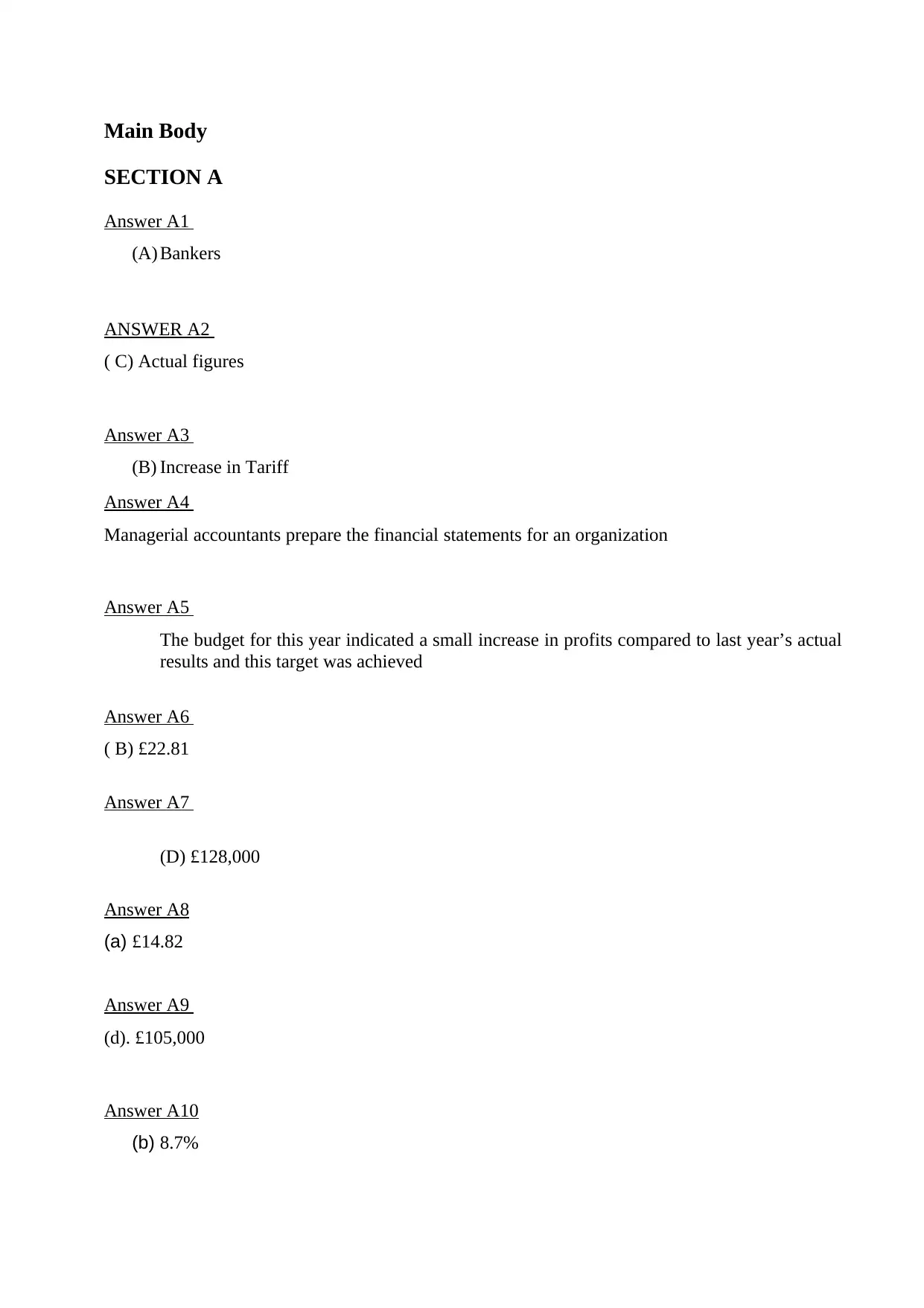
Main Body
SECTION A
Answer A1
(A) Bankers
ANSWER A2
( C) Actual figures
Answer A3
(B) Increase in Tariff
Answer A4
Managerial accountants prepare the financial statements for an organization
Answer A5
The budget for this year indicated a small increase in profits compared to last year’s actual
results and this target was achieved
Answer A6
( B) £22.81
Answer A7
(D) £128,000
Answer A8
(a) £14.82
Answer A9
(d). £105,000
Answer A10
(b) 8.7%
SECTION A
Answer A1
(A) Bankers
ANSWER A2
( C) Actual figures
Answer A3
(B) Increase in Tariff
Answer A4
Managerial accountants prepare the financial statements for an organization
Answer A5
The budget for this year indicated a small increase in profits compared to last year’s actual
results and this target was achieved
Answer A6
( B) £22.81
Answer A7
(D) £128,000
Answer A8
(a) £14.82
Answer A9
(d). £105,000
Answer A10
(b) 8.7%
⊘ This is a preview!⊘
Do you want full access?
Subscribe today to unlock all pages.

Trusted by 1+ million students worldwide
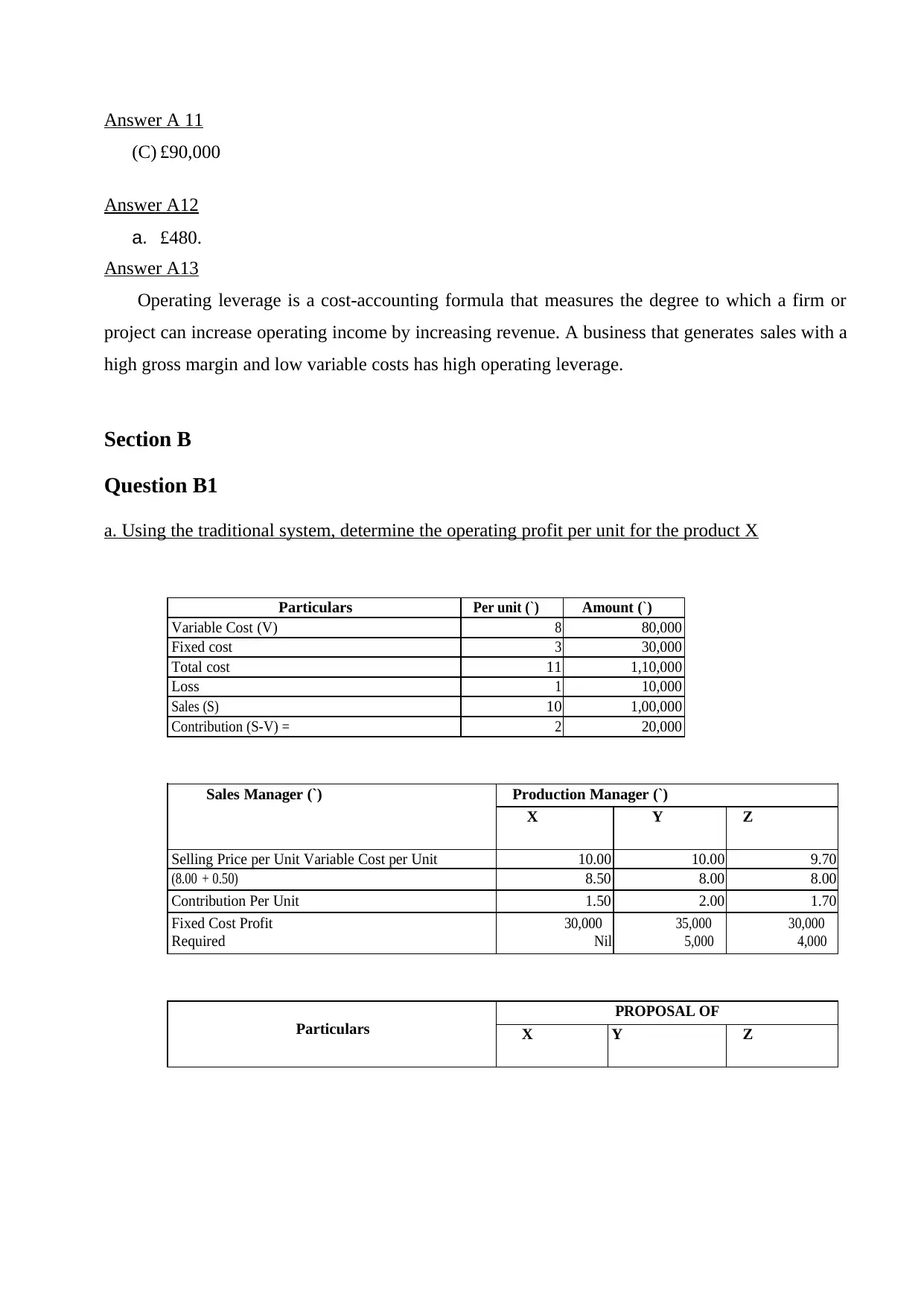
Answer A 11
(C) £90,000
Answer A12
a. £480.
Answer A13
Operating leverage is a cost-accounting formula that measures the degree to which a firm or
project can increase operating income by increasing revenue. A business that generates sales with a
high gross margin and low variable costs has high operating leverage.
Section B
Question B1
a. Using the traditional system, determine the operating profit per unit for the product X
Particulars Per unit (`) Amount (`)
Variable Cost (V) 8 80,000
Fixed cost 3 30,000
Total cost 11 1,10,000
Loss 1 10,000
Sales (S) 10 1,00,000
Contribution (S-V) = 2 20,000
Sales Manager (`) Production Manager (`)
X Y Z
Selling Price per Unit Variable Cost per Unit 10.00 10.00 9.70
(8.00 + 0.50) 8.50 8.00 8.00
Contribution Per Unit 1.50 2.00 1.70
Fixed Cost Profit
Required
30,000
Nil
35,000
5,000
30,000
4,000
Particulars
PROPOSAL OF
X Y Z
(C) £90,000
Answer A12
a. £480.
Answer A13
Operating leverage is a cost-accounting formula that measures the degree to which a firm or
project can increase operating income by increasing revenue. A business that generates sales with a
high gross margin and low variable costs has high operating leverage.
Section B
Question B1
a. Using the traditional system, determine the operating profit per unit for the product X
Particulars Per unit (`) Amount (`)
Variable Cost (V) 8 80,000
Fixed cost 3 30,000
Total cost 11 1,10,000
Loss 1 10,000
Sales (S) 10 1,00,000
Contribution (S-V) = 2 20,000
Sales Manager (`) Production Manager (`)
X Y Z
Selling Price per Unit Variable Cost per Unit 10.00 10.00 9.70
(8.00 + 0.50) 8.50 8.00 8.00
Contribution Per Unit 1.50 2.00 1.70
Fixed Cost Profit
Required
30,000
Nil
35,000
5,000
30,000
4,000
Particulars
PROPOSAL OF
X Y Z
Paraphrase This Document
Need a fresh take? Get an instant paraphrase of this document with our AI Paraphraser
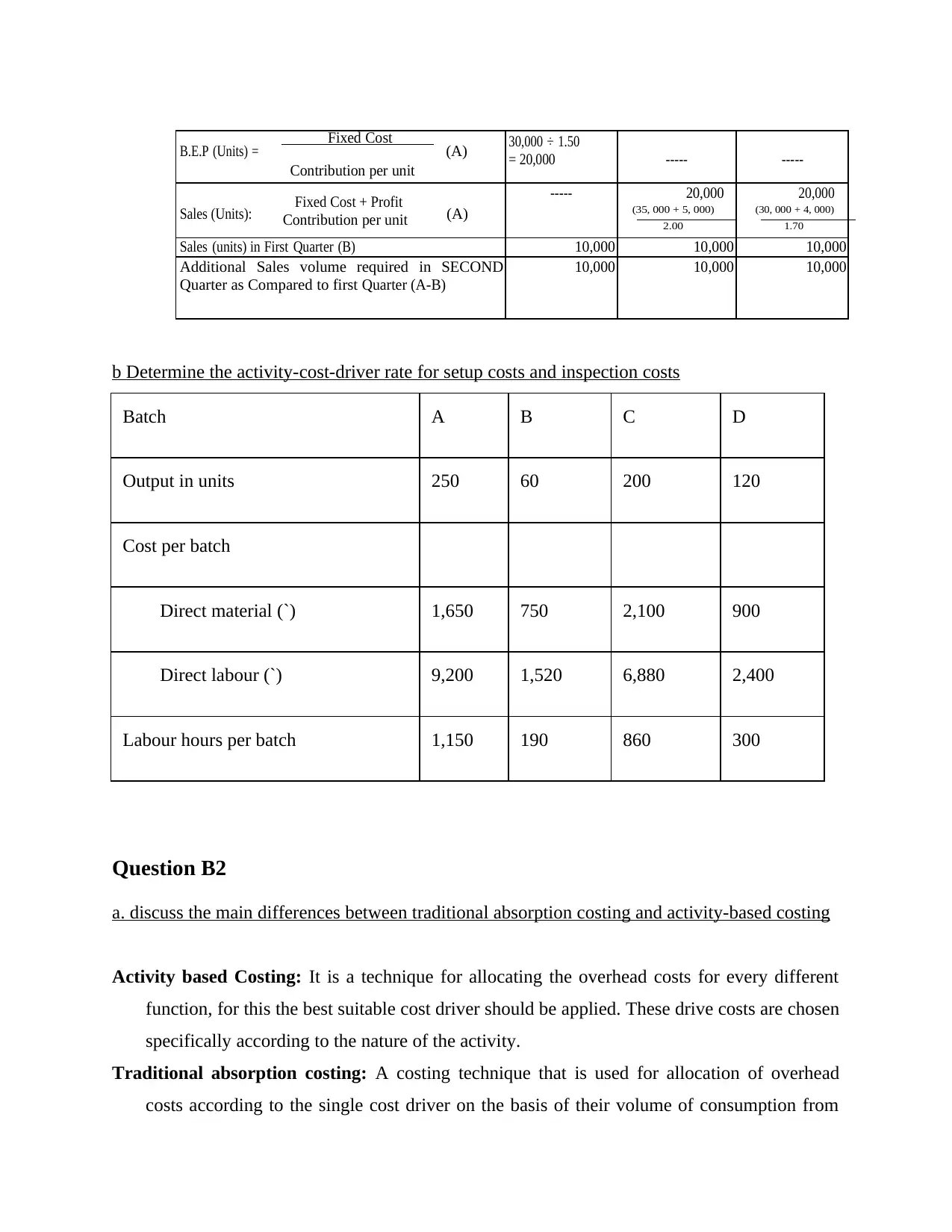
B.E.P (Units) = Fixed Cost (A)
Contribution per unit
30,000 ÷ 1.50
= 20,000 ----- -----
Sales (Units): Fixed Cost + Profit (A)Contribution per unit
----- 20,000
(35, 000 + 5, 000)
2.00
20,000
(30, 000 + 4, 000)
1.70
Sales (units) in First Quarter (B) 10,000 10,000 10,000
Additional Sales volume required in SECOND
Quarter as Compared to first Quarter (A-B)
10,000 10,000 10,000
b Determine the activity-cost-driver rate for setup costs and inspection costs
Batch A B C D
Output in units 250 60 200 120
Cost per batch
Direct material (`) 1,650 750 2,100 900
Direct labour (`) 9,200 1,520 6,880 2,400
Labour hours per batch 1,150 190 860 300
Question B2
a. discuss the main differences between traditional absorption costing and activity-based costing
Activity based Costing: It is a technique for allocating the overhead costs for every different
function, for this the best suitable cost driver should be applied. These drive costs are chosen
specifically according to the nature of the activity.
Traditional absorption costing: A costing technique that is used for allocation of overhead
costs according to the single cost driver on the basis of their volume of consumption from
Contribution per unit
30,000 ÷ 1.50
= 20,000 ----- -----
Sales (Units): Fixed Cost + Profit (A)Contribution per unit
----- 20,000
(35, 000 + 5, 000)
2.00
20,000
(30, 000 + 4, 000)
1.70
Sales (units) in First Quarter (B) 10,000 10,000 10,000
Additional Sales volume required in SECOND
Quarter as Compared to first Quarter (A-B)
10,000 10,000 10,000
b Determine the activity-cost-driver rate for setup costs and inspection costs
Batch A B C D
Output in units 250 60 200 120
Cost per batch
Direct material (`) 1,650 750 2,100 900
Direct labour (`) 9,200 1,520 6,880 2,400
Labour hours per batch 1,150 190 860 300
Question B2
a. discuss the main differences between traditional absorption costing and activity-based costing
Activity based Costing: It is a technique for allocating the overhead costs for every different
function, for this the best suitable cost driver should be applied. These drive costs are chosen
specifically according to the nature of the activity.
Traditional absorption costing: A costing technique that is used for allocation of overhead
costs according to the single cost driver on the basis of their volume of consumption from
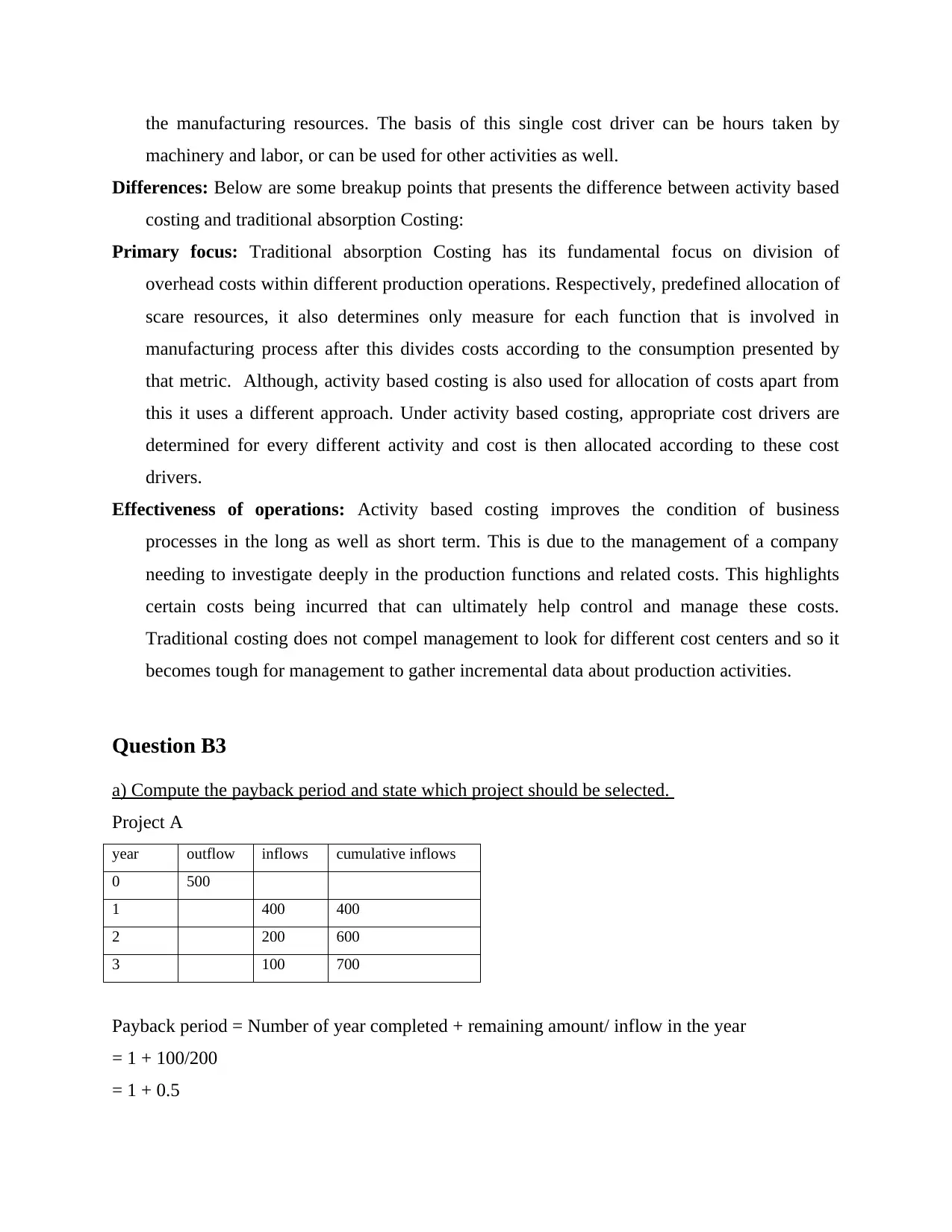
the manufacturing resources. The basis of this single cost driver can be hours taken by
machinery and labor, or can be used for other activities as well.
Differences: Below are some breakup points that presents the difference between activity based
costing and traditional absorption Costing:
Primary focus: Traditional absorption Costing has its fundamental focus on division of
overhead costs within different production operations. Respectively, predefined allocation of
scare resources, it also determines only measure for each function that is involved in
manufacturing process after this divides costs according to the consumption presented by
that metric. Although, activity based costing is also used for allocation of costs apart from
this it uses a different approach. Under activity based costing, appropriate cost drivers are
determined for every different activity and cost is then allocated according to these cost
drivers.
Effectiveness of operations: Activity based costing improves the condition of business
processes in the long as well as short term. This is due to the management of a company
needing to investigate deeply in the production functions and related costs. This highlights
certain costs being incurred that can ultimately help control and manage these costs.
Traditional costing does not compel management to look for different cost centers and so it
becomes tough for management to gather incremental data about production activities.
Question B3
a) Compute the payback period and state which project should be selected.
Project A
year outflow inflows cumulative inflows
0 500
1 400 400
2 200 600
3 100 700
Payback period = Number of year completed + remaining amount/ inflow in the year
= 1 + 100/200
= 1 + 0.5
machinery and labor, or can be used for other activities as well.
Differences: Below are some breakup points that presents the difference between activity based
costing and traditional absorption Costing:
Primary focus: Traditional absorption Costing has its fundamental focus on division of
overhead costs within different production operations. Respectively, predefined allocation of
scare resources, it also determines only measure for each function that is involved in
manufacturing process after this divides costs according to the consumption presented by
that metric. Although, activity based costing is also used for allocation of costs apart from
this it uses a different approach. Under activity based costing, appropriate cost drivers are
determined for every different activity and cost is then allocated according to these cost
drivers.
Effectiveness of operations: Activity based costing improves the condition of business
processes in the long as well as short term. This is due to the management of a company
needing to investigate deeply in the production functions and related costs. This highlights
certain costs being incurred that can ultimately help control and manage these costs.
Traditional costing does not compel management to look for different cost centers and so it
becomes tough for management to gather incremental data about production activities.
Question B3
a) Compute the payback period and state which project should be selected.
Project A
year outflow inflows cumulative inflows
0 500
1 400 400
2 200 600
3 100 700
Payback period = Number of year completed + remaining amount/ inflow in the year
= 1 + 100/200
= 1 + 0.5
⊘ This is a preview!⊘
Do you want full access?
Subscribe today to unlock all pages.

Trusted by 1+ million students worldwide
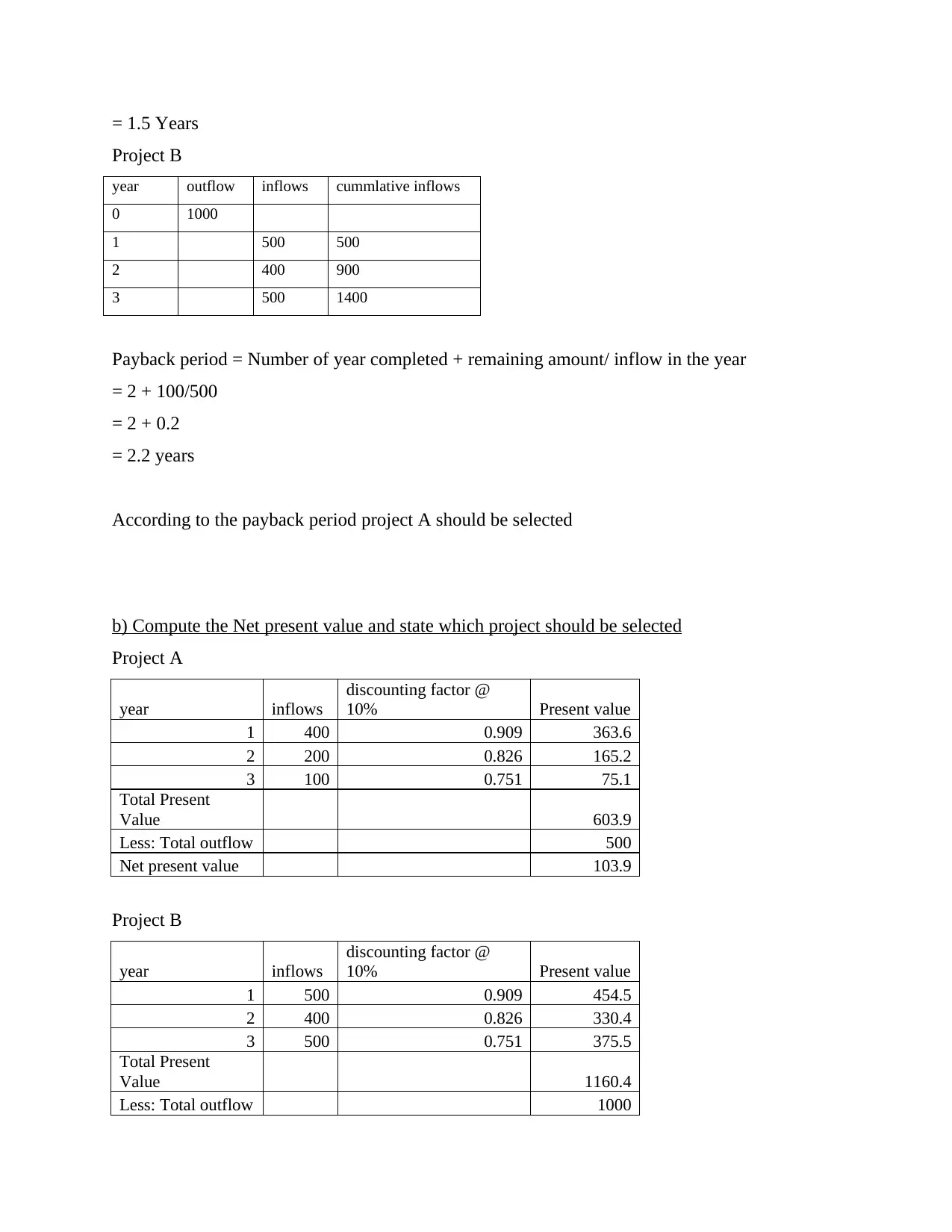
= 1.5 Years
Project B
year outflow inflows cummlative inflows
0 1000
1 500 500
2 400 900
3 500 1400
Payback period = Number of year completed + remaining amount/ inflow in the year
= 2 + 100/500
= 2 + 0.2
= 2.2 years
According to the payback period project A should be selected
b) Compute the Net present value and state which project should be selected
Project A
year inflows
discounting factor @
10% Present value
1 400 0.909 363.6
2 200 0.826 165.2
3 100 0.751 75.1
Total Present
Value 603.9
Less: Total outflow 500
Net present value 103.9
Project B
year inflows
discounting factor @
10% Present value
1 500 0.909 454.5
2 400 0.826 330.4
3 500 0.751 375.5
Total Present
Value 1160.4
Less: Total outflow 1000
Project B
year outflow inflows cummlative inflows
0 1000
1 500 500
2 400 900
3 500 1400
Payback period = Number of year completed + remaining amount/ inflow in the year
= 2 + 100/500
= 2 + 0.2
= 2.2 years
According to the payback period project A should be selected
b) Compute the Net present value and state which project should be selected
Project A
year inflows
discounting factor @
10% Present value
1 400 0.909 363.6
2 200 0.826 165.2
3 100 0.751 75.1
Total Present
Value 603.9
Less: Total outflow 500
Net present value 103.9
Project B
year inflows
discounting factor @
10% Present value
1 500 0.909 454.5
2 400 0.826 330.4
3 500 0.751 375.5
Total Present
Value 1160.4
Less: Total outflow 1000
Paraphrase This Document
Need a fresh take? Get an instant paraphrase of this document with our AI Paraphraser
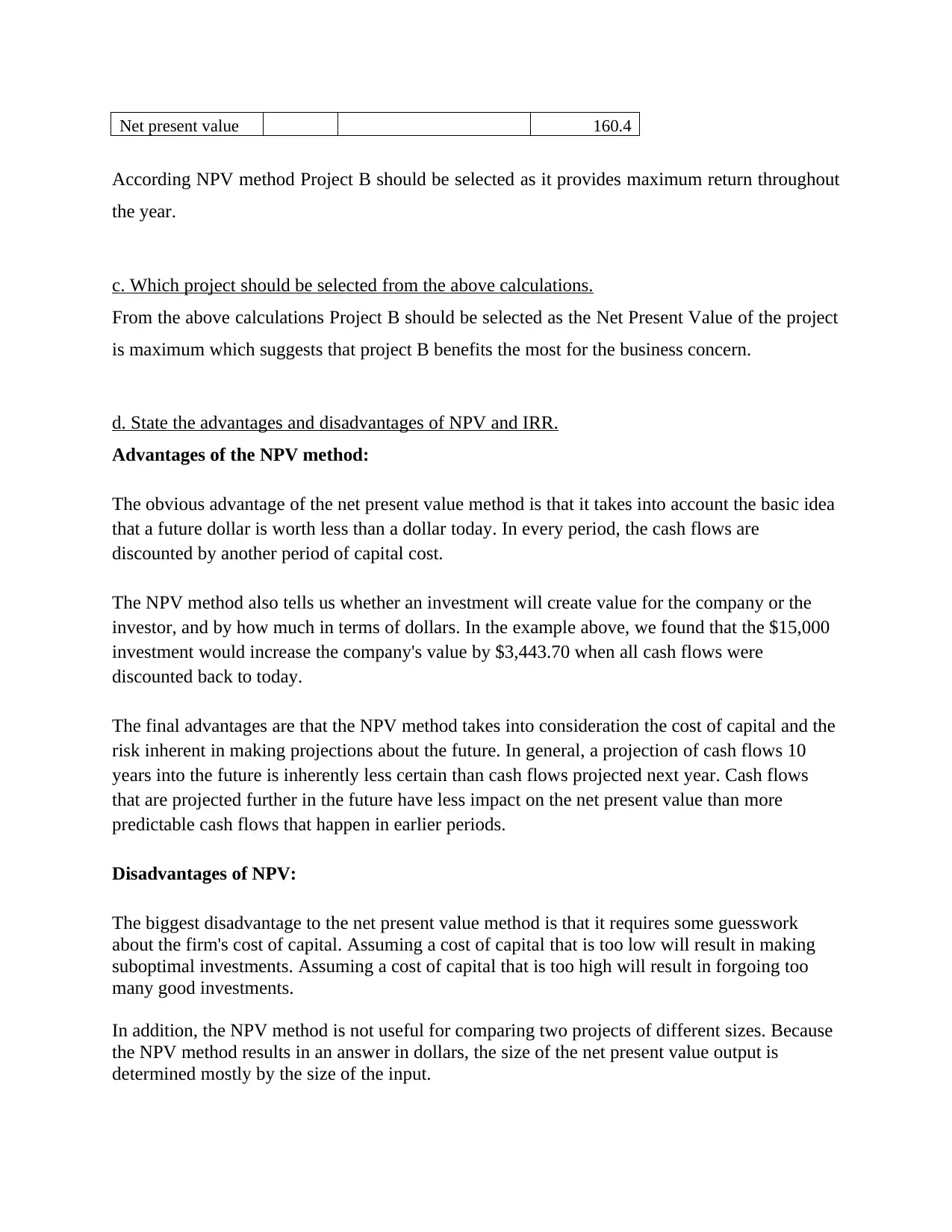
Net present value 160.4
According NPV method Project B should be selected as it provides maximum return throughout
the year.
c. Which project should be selected from the above calculations.
From the above calculations Project B should be selected as the Net Present Value of the project
is maximum which suggests that project B benefits the most for the business concern.
d. State the advantages and disadvantages of NPV and IRR.
Advantages of the NPV method:
The obvious advantage of the net present value method is that it takes into account the basic idea
that a future dollar is worth less than a dollar today. In every period, the cash flows are
discounted by another period of capital cost.
The NPV method also tells us whether an investment will create value for the company or the
investor, and by how much in terms of dollars. In the example above, we found that the $15,000
investment would increase the company's value by $3,443.70 when all cash flows were
discounted back to today.
The final advantages are that the NPV method takes into consideration the cost of capital and the
risk inherent in making projections about the future. In general, a projection of cash flows 10
years into the future is inherently less certain than cash flows projected next year. Cash flows
that are projected further in the future have less impact on the net present value than more
predictable cash flows that happen in earlier periods.
Disadvantages of NPV:
The biggest disadvantage to the net present value method is that it requires some guesswork
about the firm's cost of capital. Assuming a cost of capital that is too low will result in making
suboptimal investments. Assuming a cost of capital that is too high will result in forgoing too
many good investments.
In addition, the NPV method is not useful for comparing two projects of different sizes. Because
the NPV method results in an answer in dollars, the size of the net present value output is
determined mostly by the size of the input.
According NPV method Project B should be selected as it provides maximum return throughout
the year.
c. Which project should be selected from the above calculations.
From the above calculations Project B should be selected as the Net Present Value of the project
is maximum which suggests that project B benefits the most for the business concern.
d. State the advantages and disadvantages of NPV and IRR.
Advantages of the NPV method:
The obvious advantage of the net present value method is that it takes into account the basic idea
that a future dollar is worth less than a dollar today. In every period, the cash flows are
discounted by another period of capital cost.
The NPV method also tells us whether an investment will create value for the company or the
investor, and by how much in terms of dollars. In the example above, we found that the $15,000
investment would increase the company's value by $3,443.70 when all cash flows were
discounted back to today.
The final advantages are that the NPV method takes into consideration the cost of capital and the
risk inherent in making projections about the future. In general, a projection of cash flows 10
years into the future is inherently less certain than cash flows projected next year. Cash flows
that are projected further in the future have less impact on the net present value than more
predictable cash flows that happen in earlier periods.
Disadvantages of NPV:
The biggest disadvantage to the net present value method is that it requires some guesswork
about the firm's cost of capital. Assuming a cost of capital that is too low will result in making
suboptimal investments. Assuming a cost of capital that is too high will result in forgoing too
many good investments.
In addition, the NPV method is not useful for comparing two projects of different sizes. Because
the NPV method results in an answer in dollars, the size of the net present value output is
determined mostly by the size of the input.
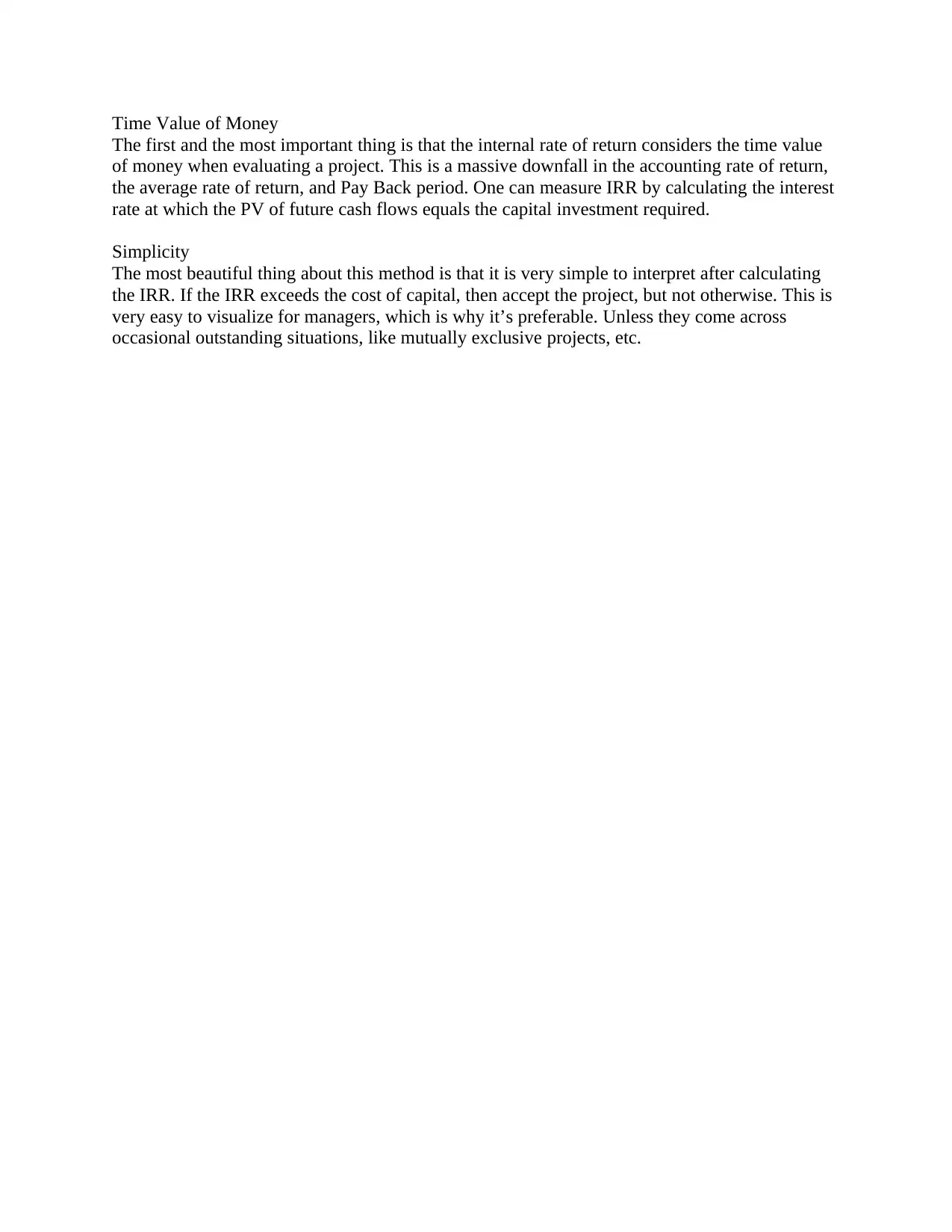
Time Value of Money
The first and the most important thing is that the internal rate of return considers the time value
of money when evaluating a project. This is a massive downfall in the accounting rate of return,
the average rate of return, and Pay Back period. One can measure IRR by calculating the interest
rate at which the PV of future cash flows equals the capital investment required.
Simplicity
The most beautiful thing about this method is that it is very simple to interpret after calculating
the IRR. If the IRR exceeds the cost of capital, then accept the project, but not otherwise. This is
very easy to visualize for managers, which is why it’s preferable. Unless they come across
occasional outstanding situations, like mutually exclusive projects, etc.
The first and the most important thing is that the internal rate of return considers the time value
of money when evaluating a project. This is a massive downfall in the accounting rate of return,
the average rate of return, and Pay Back period. One can measure IRR by calculating the interest
rate at which the PV of future cash flows equals the capital investment required.
Simplicity
The most beautiful thing about this method is that it is very simple to interpret after calculating
the IRR. If the IRR exceeds the cost of capital, then accept the project, but not otherwise. This is
very easy to visualize for managers, which is why it’s preferable. Unless they come across
occasional outstanding situations, like mutually exclusive projects, etc.
⊘ This is a preview!⊘
Do you want full access?
Subscribe today to unlock all pages.

Trusted by 1+ million students worldwide
1 out of 9
Related Documents
Your All-in-One AI-Powered Toolkit for Academic Success.
+13062052269
info@desklib.com
Available 24*7 on WhatsApp / Email
![[object Object]](/_next/static/media/star-bottom.7253800d.svg)
Unlock your academic potential
Copyright © 2020–2025 A2Z Services. All Rights Reserved. Developed and managed by ZUCOL.




